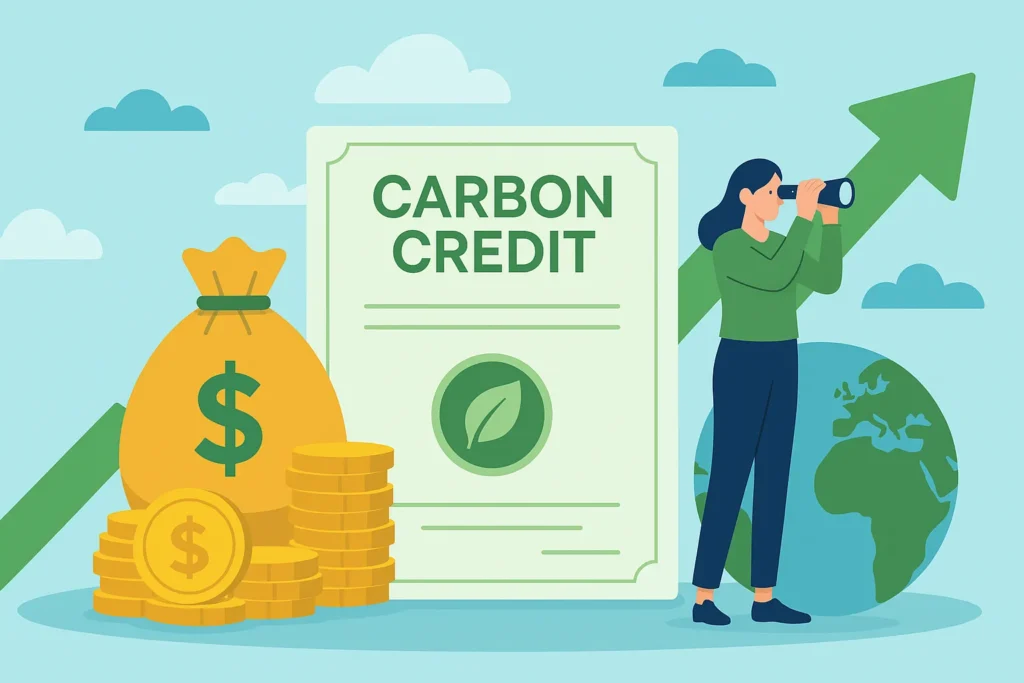Ever wondered how companies offset their environmental impact? Or maybe you’ve heard whispers of a market where pollution is traded? It sounds complex, but understanding the carbon credit market explained simply is more accessible than you might think.
This article will break down the ins and outs of this important system, from how carbon credits are generated to how they’re used to combat climate change. Get ready to demystify the world of carbon trading!
What is the Carbon Credit Market?
The carbon credit market is essentially a system designed to reduce greenhouse gas emissions. It operates on the principle of incentivizing companies to lower their carbon footprint.
Think of it as a marketplace where carbon emissions are bought and sold. Companies that reduce their emissions below a set limit can sell their excess “credits” to companies that exceed their limits.
How Carbon Credits Work
A carbon credit represents one tonne of carbon dioxide (or its equivalent in other greenhouse gases) that has been removed or prevented from entering the atmosphere.
Each credit gives the holder the right to emit one tonne of CO2. This creates a financial incentive for companies to reduce their emissions.
Cap-and-Trade vs. Carbon Offset Markets
There are two main types of carbon markets: cap-and-trade systems and carbon offset markets.
Cap-and-Trade: A government sets a limit (cap) on the total amount of emissions allowed within a specific sector. Companies receive or purchase allowances (permits) to emit a certain amount. Those exceeding their allowance must buy credits from those who emit less.
Carbon Offset Markets: These markets involve projects that reduce or remove greenhouse gases from the atmosphere, such as reforestation or renewable energy initiatives. Companies can purchase credits from these projects to offset their own emissions.
The Purpose of the Carbon Credit Market
The primary goal of the carbon credit market is to mitigate climate change by reducing greenhouse gas emissions globally.
It aims to achieve this by putting a price on carbon, making it more economically attractive for companies to invest in cleaner technologies and practices.
Incentivizing Emission Reduction
By assigning a monetary value to carbon emissions, the market encourages businesses to find innovative ways to reduce their carbon footprint.
This can lead to investments in energy efficiency, renewable energy sources, and other sustainable practices.
Promoting Sustainable Development
Carbon offset projects often have additional benefits beyond emission reduction.
They can support local communities, protect biodiversity, and promote sustainable development in developing countries.
Meeting Climate Goals
The carbon credit market plays a crucial role in helping countries and companies meet their climate goals under international agreements like the Paris Agreement.
It provides a mechanism for achieving emission reduction targets and contributing to a low-carbon future.
How Carbon Credits are Generated
Carbon credits are generated through projects that reduce or remove greenhouse gas emissions. These projects can range from large-scale renewable energy installations to small-scale community-based initiatives.
Renewable Energy Projects

Projects that generate electricity from renewable sources, such as solar, wind, and hydropower, can earn carbon credits.
These projects displace electricity generated from fossil fuels, thereby reducing emissions.
Reforestation and Afforestation Projects
Planting trees (reforestation) or establishing forests on previously non-forested land (afforestation) can sequester carbon dioxide from the atmosphere.
These projects generate carbon credits based on the amount of carbon stored in the trees and soil.
Energy Efficiency Projects
Projects that improve energy efficiency, such as upgrading building insulation or installing more efficient equipment, can reduce energy consumption and emissions.
These projects generate carbon credits based on the energy savings achieved.
Industrial Gas Destruction Projects
Some industrial processes release potent greenhouse gases, such as HFCs and PFCs.
Projects that capture and destroy these gases can earn carbon credits based on the amount of gas destroyed.
Methane Capture Projects
Methane is a powerful greenhouse gas emitted from landfills, coal mines, and agricultural operations.
Projects that capture and utilize or destroy methane can earn carbon credits.
Participants in the Carbon Credit Market
The carbon credit market involves a variety of participants, each playing a different role in the buying, selling, and verification of carbon credits.
Project Developers
These are the organizations or individuals who develop and implement projects that generate carbon credits.
They are responsible for ensuring that their projects meet the requirements of the relevant carbon standards.
Verifiers
Independent third-party organizations verify that carbon offset projects are actually reducing or removing greenhouse gas emissions.
This verification process is crucial for ensuring the integrity and credibility of the carbon market.
Buyers
Buyers of carbon credits can include companies, governments, and individuals who want to offset their own emissions.
They may purchase credits to comply with regulations, meet voluntary sustainability goals, or enhance their corporate social responsibility.
Brokers and Traders
Brokers and traders facilitate the buying and selling of carbon credits, connecting buyers and sellers and providing market information.
They play a key role in ensuring liquidity and efficiency in the carbon market.
Regulators
Governments and international organizations regulate the carbon market, setting rules and standards for the generation, verification, and trading of carbon credits.
Their role is to ensure that the market operates effectively and achieves its intended goals.
Benefits of the Carbon Credit Market
The carbon credit market offers a range of benefits, both environmental and economic.
Reduced Greenhouse Gas Emissions

The primary benefit of the carbon credit market is the reduction of greenhouse gas emissions, which helps to mitigate climate change.
By putting a price on carbon, the market incentivizes companies to reduce their emissions and invest in cleaner technologies.
Investment in Clean Technologies
The carbon credit market encourages investment in clean technologies and sustainable practices.
Companies can earn revenue from selling carbon credits generated by these projects, making them more financially attractive.
Economic Opportunities
The carbon credit market creates economic opportunities for project developers, verifiers, brokers, and other participants.
It can also stimulate economic growth in developing countries by supporting sustainable development projects.
Improved Energy Efficiency
The carbon credit market encourages companies to improve their energy efficiency, which can reduce energy consumption and costs.
This can lead to significant savings for businesses and consumers.
Increased Awareness of Climate Change
The carbon credit market raises awareness of climate change and its impacts.
It encourages companies and individuals to take responsibility for their emissions and find ways to reduce their carbon footprint.
Challenges and Criticisms of the Carbon Credit Market
Despite its benefits, the carbon credit market faces several challenges and criticisms.
Additionality Concerns
One of the main concerns is additionality, which means that carbon offset projects must demonstrate that they would not have occurred without the revenue from carbon credits.
It can be difficult to prove that a project is truly additional, and some projects may have been implemented anyway.
Permanence Issues
Another challenge is ensuring the permanence of carbon reductions. For example, trees planted in a reforestation project could be cut down or destroyed by fire, releasing the stored carbon back into the atmosphere.
Carbon credits must be carefully managed to ensure that reductions are truly permanent.
Leakage
Leakage occurs when emission reductions in one area are offset by increased emissions in another area.
For example, a project that protects a forest from logging in one area could lead to increased logging in another area.
Verification Challenges
Verifying the actual emission reductions achieved by carbon offset projects can be complex and costly.
It is important to have robust verification processes to ensure the integrity of the carbon market.
Lack of Transparency
Some carbon markets lack transparency, making it difficult for buyers to assess the quality and credibility of carbon credits.
Increased transparency is needed to build trust in the carbon market.
The Future of the Carbon Credit Market
The future of the carbon credit market looks promising, with increasing demand for carbon credits and growing recognition of their role in mitigating climate change.
Increased Demand for Carbon Credits
As companies and governments set more ambitious climate goals, the demand for carbon credits is expected to increase.
This will drive investment in carbon offset projects and stimulate the growth of the carbon market.
Standardization and Regulation
Efforts are underway to standardize and regulate the carbon market, which will improve its credibility and effectiveness.
This includes developing common standards for the generation, verification, and trading of carbon credits.
Integration with National and International Policies
The carbon credit market is increasingly being integrated with national and international climate policies.
This will help to ensure that the market operates in a consistent and effective manner.
Technological Advancements
Technological advancements are making it easier to monitor and verify carbon reductions.
This includes the use of satellite imagery, remote sensing, and blockchain technology.
Focus on High-Quality Credits
There is a growing focus on high-quality carbon credits that deliver real and verifiable emission reductions.
Buyers are increasingly seeking out credits from projects that have strong environmental and social benefits.
Navigating the Carbon Credit Market
Participating in the carbon credit market can seem daunting, but understanding the key steps can make the process smoother.
Due Diligence
Thoroughly research the carbon credit projects you’re considering. Look for projects with strong verification and clear methodologies.
Understanding Standards
Familiarize yourself with different carbon standards like the Verified Carbon Standard (VCS) or the Gold Standard. Each has its own criteria for project eligibility and credit issuance.
Risk Assessment
Assess the risks associated with the project, including permanence, additionality, and leakage.
Contractual Agreements
Ensure that you have clear contractual agreements with project developers or brokers, outlining the terms of the carbon credit purchase.
Verification
Verify the carbon credits through reputable third-party verifiers to ensure their quality and credibility.
Conclusion
The carbon credit market explained simply is a powerful tool for combating climate change. While it has its challenges, its potential to incentivize emission reductions and promote sustainable development is undeniable. By understanding how it works, its benefits, and its criticisms, you can engage more effectively in creating a sustainable future. Whether you’re a business, an investor, or simply a concerned citizen, the carbon credit market offers a pathway to making a real difference.
Ready to explore carbon offsetting for your business? Or perhaps you have insights to share about your experiences with carbon credits? Let’s discuss in the comments below!
Frequently Asked Questions (FAQ)
What is the difference between voluntary and compliance carbon markets?
Voluntary carbon markets are driven by companies and individuals choosing to offset their emissions, often for corporate social responsibility. Compliance markets are created by mandatory emission reduction regulations, such as cap-and-trade systems.
How do I know if a carbon credit is legitimate?
Look for carbon credits that are verified by reputable third-party organizations and adhere to recognized carbon standards like VCS or the Gold Standard. These standards ensure that projects meet rigorous criteria for emission reduction and additionality.
Are carbon credits a long-term solution to climate change?
Carbon credits are a valuable tool, but not a singular solution. They should be part of a broader strategy that includes reducing emissions at the source, investing in renewable energy, and implementing sustainable practices.

